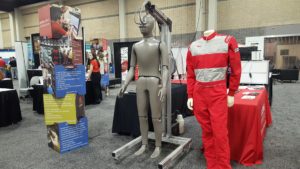
The expectations of today’s technical textiles are changing rapidly, requiring the creative use of textile testing to validate the functionality of protective clothing and active wear, as well as establishing new standards for wearable electronics and textile products with unique functional characteristics.
The Advanced Textiles Testing Track at IFAI Expo examined textile testing in light of this new wave of textile developments. Dr. Emiel Den Hartog of the North Carolina State University (NCSU) Center for Research on Textile Protection & Comfort (TPACC) focused on a “multi-level” approach to assessing comfort, ergonomics and functionality in protective clothing.
While testing in the lab is likely to be more accurate, testing in the field has more relevance, according to Den Hartog. “We need to define the optimum balance between protective performance, clothing comfort, and physiological strain,” he maintained.
Dr. Jesse Jur of NCSU’s Dept. of Textile Engineering, Chemistry and Science outlined the process his group developed to test electronic textiles using conductive inks printed onto TPU film for use on knitted shirts. Using a stress/strain curve as the testing mechanism, the circuitry was fine-tuned for maximum efficiency and durability.
Jur explained that the category of wearables will require a raft of new testing standards, including the impact of wearing electronics on the body.
Dave Klein of Thomsen Research Associates spoke about the many antimicrobial options and test methods on the market, pointing out that today’s newer “greener” formulations may require different types of testing.
Performance testing for the many functions of active wear, from water repellency and breathability, to UV protection and thermal regulation, was expanded upon by Seemanta Mitra, senior director of global softlines for Intertek.
Dr. Jan Beringer of the Hohenstein Institute summed up the challenges of testing today’s innovative textiles by advising development and testing teams to “get creative, but stay scientific.” Projects such as comparing the performance of faux fur to real fur, or testing the noise level of outdoor fabrics worn in stealth situations, required “looking at the whole picture” to develop appropriate test methods.
The day-long testing track fulfilled a portion of the requirements needed to earn a testing certificate as credit toward the NCSU Textile Technology Certificate Program.
Debra Cobb is a North Carolina-based writer with extensive expertise in textiles.
 TEXTILES.ORG
TEXTILES.ORG


